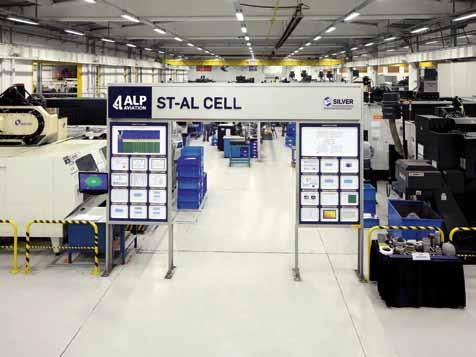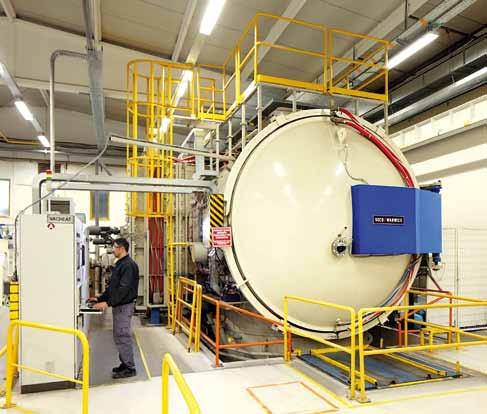
6 minute read
Alp Aviation • Mustafa Kemal Erçelik
Mustafa Kemal Erçelik
Board Member of Alp Aviation Located in the city of Eskisehir, the cradle of the Turkish aerospace industry, Alp Aviation is the story of a successful defense and aerospace private corporation. Created in 1998, the company has grown tremendously over the past 15 years and is currently in a joint venture with Sikorsky, a global leader. Today, Alp Aviation is the largest private aerospace exporter in Turkey.
Advertisement
What are the main products and services that Alp Aviation provides to the Turkish market?
Alp Aviation manufactures and exports rotarywing dynamic components and flight control hardware for all Sikorsky platforms, such as swash plate assemblies, bifilar, pressure plate assemblies, damper bracket assemblies, pitch-beams and horn assemblies. Also, as part of the Turkish Utility Helicopter program with Sikorsky, our product line expansion will include the production of all major flight critical and dynamic components, as well as assemblies such as gears, gear boxes and spindles for Black Hawk. Alp Aviation is also the source of Black Hawk and Seahawk Tail Rotor Drive Shaft (TRDS) details and assemblies. Dynamically balanced, fully finished assemblies are shipped to
meet the requirements of final helicopter assembly lines and spare needs of users. With a dedicated engine components facility and business unit, Alp Aviation produces engine rotating hardware such as integrally bladed fan and compressor rotors (IBRs) for Pratt & Whitney’s F135, other key engine and auxiliary power unit (APU) components for Boeing 787 and Airbus 380 programs and fuel and oil housings for Pratt & Whitney Canada engine programs. Furthermore, our cooperation with Pratt & Whitney is now moving into Pratt & Whitney’s new generation gear turbo fan engines. Alp Aviation is the major source for Pratt & Whitney F135 stage two to five titanium IBRs. An R&D contract was also signed in November 2011 between Alp and Pratt & Whitney to develop F135 stages six to nine nickel IBR. Alp Aviation also produces landing gear parts and subassemblies for F-35 Joint Strike Fighter (JSF), F-22 and Boeing commercial programs equipped with Goodrich landing gear systems. The first JSF flight carried more than 40 Alp made parts in its landing gears. Collar, torque arms and drag brace assemblies and 300M and AERMET 100 alloy components are currently in production. Alp Aviation is the candidate for becoming the F-35 landing gear final assembly and check out (FACO) and maintenance, repair and overhaul (MRO) center. Alp Aviation, as part of the Turkish Utility Helicopter Program (TUHP), will manufacture the landing gear assemblies. Alp Aviation is the source of the rudder and horizontal stabilizer for the TAI’s Turkish Basic Trainer program, as well as Sikorsky’s Black Hawk horizontal stabilizer center box assembly, among others. Alp Aviation is a fully integrated titanium machining and special processing house, with strong experience in wrought titanium, forgings and castings. In order to provide finished titanium products and assemblies four and five axes precision machining equipment, all in-house special processes and final acceptance tests are utilized. Alp Aviation’s basic strength and competitive advantage come from its vertically integrated, yet very efficient, operations, its investments in people and operating modern technology systems. This is reflected in its very attractive quality, delivery and cost performance.
How do you ensure the quality of your industrial output?
Alp Aviation facilities are in perfect accordance with the Achieving Competitive Excellence (ACE) principles and successfully demonstrate visual factory and lean manufacturing principles. The quality system is in accordance with the requirements of the global aerospace industry, as reflected in the highest level quality certifications that Alp Aviation possesses, including AS EN 9100, NADCAP Certification for all special processes, Flight Safety Parts Manufacturing Approvals and quality system compliance for customers such as Sikorsky, Pratt & Whitney, Lockheed Martin and
UTC Aerospace Systems. Alp Aviation is comprised of 13 lean cells to achieve its lean manufacturing principles. We were awarded “ACE Silver Level” on 10 cells and “ACE Gold Level” on three cells in the UTC ACE Gold Program. All cells and enterprises shall reach Gold Level by the third quarter of 2014, the highest degree in the ACE system. In addition to this, the state-of-the-art enterprise resource planning (ERP) system is utilized in the management of the entire manufacturing process as well as corporate functions. The above systems help to achieve 100% quality and over 97% on-time delivery performance, in accordance with the ACE Gold standards. In addition to what I just mentioned, I must stress that our state-of-the-art ERP system is used to monitor all measurable functions on a real time basis. This is all done with smart screens and bar codes to ensure that our quality rating remains high. Another element that I should mention about Alp Aviation is that we have an ITO Quality Clinic, recognized by UTC and we are the sole UTC approved enterprise of its kind nationally and regionally. While this recognition shows the level of quality, it also helps our efforts to enhance our “zero escape” policy.
What can you tell us about the recent establishment of AlpTeknik?
Most of Alp Aviation’s current revenue comes from the production programs and some comes from spare parts. If our product is a spare part, we are generally meeting a good portion of the spare parts requirements. We decided to develop an indigenous enterprise, which would be a subsidiary of Alp Aviation, to work on the aftermarket business in a specialized manner. It starts with the spare requirements for Sikorsky Aircraft Services (SAS) products that include Sikorsky platforms and some other platforms that Sikorsky companies are servicing. AlpTeknik is the sole distributor of SAS products in Turkey. As a part of this activity and for the first time in Turkey, we are going to keep a local inventory of the high-turnover parts for Turkish users that will allow them to receive their parts in hours or days rather than months, as is the case at the moment. This will allow higher utilization of aircraft and we want to expand our Sikorsky relationship further into other after market operations beyond part distribution and part warehousing. We expect this to grow and progress over the coming years and we would like to offer this service to other UTC and non-UTC companies in the future. Our office in Ankara started its operations in 2013, however, the official opening is planned for 2014.
How do you see the potential of the Turkish defense industry?
Although Turkish defense and aerospace sector output and exports are quite small relative to total Turkish GDP and exports today, the Turkish government is giving great impetus to the sector. One of the most important reasons is naturally the strategic and security dimension of the sector. This is also a critical sector in technology development and R&D, thus also supporting overall national technological infrastructure. Through the import substitution effect, relatively higher value added performance and high actual and expected growth rates also make the sector quite attractive and promising for the policy makers as a part of their strategic plans to reduce the current structural account deficit problem in the Turkish economy. This

support, coupled with expected growth, particularly in civilian aviation, and local projects such as the indigenous helicopter program, makes the industry’s outlook quite positive.
What is your export strategy?
Our exports are growing around 30% annually, and this is expected to continue over the next five to seven years at least. We are expecting significant rate increases in the Boeing 787, Airbus 380, F-35 JSF, Pratt & Whitney NGPF programs and the long awaited Turkish Utility Helicopter program. This reinforces our hopes for even bigger annual growth rates in the long term. After market operations will also start to bring extra growth potential starting from 2014. The company will offer 90 new direct employment opportunities in 2014, bringing the total to about 600. New investments in capital expenditures will be approximately 15 million dollars in 2014, excluding a combined investment of nearly 100 million dollars for TUHP and UTC’s NGPF programs, which are very likely to start in 2014, and continue through 2016.









